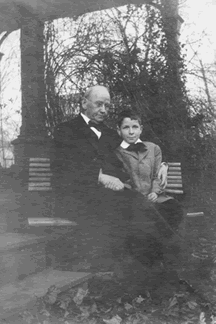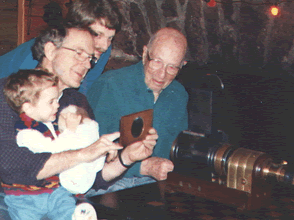
|
|
|
|
||||||||||

The Magic-Lantern - A Borton Family History(Strictly speaking, this family history isn't an "On the Road" story, but this seems the best place to put it, as it answers the most common question we get on the road, "How did you get into this life, anyway?" Portions were originally published in The Magic-Lantern Bulletin, Spring, 1982.)
And gradually, Grandfather Carter would allow himself to be drawn to the window, and gradually he would agree, yes, just perhaps, that might be the lamplighter coming down the street through the storm, and yes, it was just possible that he would get to the gas lamp in front of the house before his lighter was blown out by the wind, but no, under no circumstances could the magic-lantern be lit until it was truly dark, and the only light outside was that of the newly lit gas light, casting its flickering shadows on the screen. The ritual -- the slow tease -- continued. The lamp of the polished Marcy Sciopticon had to be carefully lit with a broom straw. The wicks had to be turned down low so as not to crack the lens. The focus had to be adjusted, the sheet had to be stretched tighter in a vain effort to erase the wrinkles. The wick had to be turned up. The focus had to be adjusted again. And finally, after all the waiting, there on the sheet was the ghostly man with the blue suit. His terrified eyes darted back and forth from child to child, hoping against hope that none of those good Quaker boys and girls would say the terrible magic word that would make his nose grow a solid foot, hit the wrinkles in the sheet, and then shoot straight up in the air. "ABRACADABRA!" the good Quaker children all screamed in unison. And so the show began. Grandfather Carter was a chemist and respected Philadelphia scientist. (He was once on a City Committee to Investigate Perpetual Motion.) As a result, his grandchildren were instructed with a heavy dose of astronomy magic-lantern slides and natural history slides and microscopic creature slides. But the slide that most enchanted Johnny was a beautiful garden fountain with water that really moved. (For one period later in his life Johnny would become a landscape gardener specializing in garden pools.) And the slide that most fascinated Johnny was of a boy carving a picture of his teacher on the schoolhouse door -- which suddenly opened to reveal the teacher himself, wielding a switch! (In later life, Johnny would become evasive when asked why this slide was especially memorable!) It was Johnny (my father) who inherited the magic-lantern and made it a part of my own upbringing in the late days of W.W.II. We no longer waited for the lamp-lighter, but the sense of ritual remained. The lantern and slides were carefully taken from their box in the outside porch. The lens always had to be removed before the show, wrapped in a clean blanket and put by the radiator to warm. The wick was still carefully lit with the end of a broom straw. During the show, the living room of our farmhouse in Alexandria, Virginia always reeked of kerosene -- for my generation an unusual smell that was as much a part of the magic-lantern experience as the man who ate the rats -- certainly our favorite slide. And -- because the shows were usually given when my grandfather (Grandfather Carter's son-in-law) came to visit, they took on an extra magical sense of the olden days. The very nature of our language shifted, from the hard staccato of war-time Washington to Grandfather Borton's "thee and thy," -- the Quaker plain speech my parents no longer used in daily life. When I had children of my own, my father gave the magic lantern to me. During the late sixties, while my kids were small, we packed the neighborhood children into our tiny Cambridge, MA apartment, providing the "music" by banging on pots and pans. Always, I was careful to warm the lens, and light the wick with ceremony. In spite of their TV sophistication, the kids were enthusiastic, with the occasional exception of my son, Mark Carter, who was sometimes annoyed by the invasion of neighbors, and embarrassed by the hidden ham emerging from his father. The magic lantern was such an integral and unique part of my upbringing that somehow it never occurred to me that there might have been thousands (millions?) of other lanterns in other families. Then our local historical society heard of the lantern, and asked for a demonstration. I put on a "show" for them, doing our family thing. Afterwards an old man came up to tell me about his own vivid childhood memories of a Sunday school teacher who ended his illustrated magic-lantern Bible Stories with the "ratcatcher" -- if the kids were good. Suddenly, I realized that of course our family was not unique. We had been part of a nineteenth-century magic-lantern culture. The Historical Society audience had roared at the ratcatcher. At the end of the show I had used a multi-colored spinning chromatrope for the finale. A little old lady had called out, "If that's what pot is like, I'll try some!" I realized the old magic could still work -- and bring delight outside the family. After a similar demonstration/show at Mystic Seaport Museum, I met with the curatorial staff, which led me to members of the Magic-Lantern Society of the US and Canada, where I was flabbergasted by the diversity of their magic-lantern collections and the variety of Americana captured by their slides. My collecting and studying and performing juices began to flow.
I don't travel with family members much these days. The professional musical talents of Nancy Stewart and Jacqueline Alvarez have replaced our old pots and pans. My wife, who helped with shows in the early days, stays home with her "day job." But occasionally my grandchildren -- the sixth generation -- help with the show. My granddaughter, who lives nearby, sometimes assists in my preparations. The two grandsons even helped once during the show, and joined us on stage for a bow at the Corcoran Museum, across from the White House in Washington. Great Grandfather Carter, their Great-Great-Great Grandfather Carter -- would have been tickled. |
|||||

| Repertoire | • | Schedule | • | About Us | • | Book Us! | • | What's New |
Last Update: June 29, 2004
Web Author: POW·R·PC
Copyright © 2003 by The American Magic-Lantern Theater - ALL RIGHTS RESERVED

